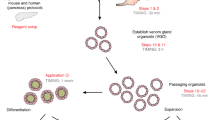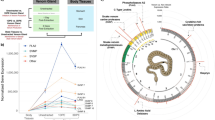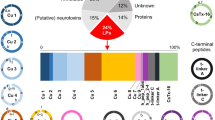Abstract
This protocol details the optimal conditions to establish a long-term primary culture of secretory cells from the venom gland of the Bothrops jararaca snake. Furthermore, these conditions allow the production and secretion of venom into the culture medium. Snake venom is a rich source of active molecules and has been used for bioprospection studies. However, obtaining enough venom from snakes is a major obstacle. Secretory cells of venom glands are capable of producing active toxins. Therefore, a culture of secretory cells is a good in vitro system to acquire the venom of snakes without capturing the animal from the wild. The protocol described here provides a rapid (∼4 h) and reproducible means of producing sufficient amounts of snake venom for biological investigations.
This is a preview of subscription content, access via your institution
Access options
Subscribe to this journal
Receive 12 print issues and online access
$259.00 per year
only $21.58 per issue
Buy this article
- Purchase on Springer Link
- Instant access to full article PDF
Prices may be subject to local taxes which are calculated during checkout



Similar content being viewed by others
References
Carneiro, S.M. et al. Venom production in long-term primary culture of secretory cells of the Bothrops jararaca venom gland. Toxicon 47, 87–94 (2006).
Laing, G.D. & Moura-da-Silva, A.M. Jararhagin and its multiple effects on hemostasis. Toxicon 45, 987–996 (2005).
Quissell, D.O., Redman, R.S. & Mark, M.R. Short-term primary culture of acinar-intercalated duct complexes from rat submandibular glands. In Vitro Cell. Dev. Biol. 22, 469–480 (1986).
Redman, R.S., Quissell, D.O. & Barzen, K.A. Effects of dexamethasone, epidermal growth factor, and retinoic acid on rat submandibular acinar-intercalated duct complexs in primary culture. In Vitro Cell. Dev. Biol. 24, 734–742 (1988).
Kochva, E. The origin of snakes and evolution of the venom gland apparatus. Toxicon 25, 65–106 (1987).
Belluomini, H.E. In Venomous Animals and Their Venoms Vol. 1 (eds. Bucherl, W., Buckley, V. & Deulofeu, V.) 97–117 (Academic Press, New York, 1968).
Devi, A. The protein and nonprotein constituents of snake venoms. In Venomous Animals and Their Venoms Vol. 1 (eds. Bucherl, W., Buckley, V. & Deulofeu, V.) 119–165 (Academic Press, New York, USA, 1968).
Carneiro, S.M., Fernandes, W., Sant'anna, S.S. & Yamanouye, N. Microvesicles in the venom of Crotalus durissus terrificus (Serpente, Viperidae). Toxicon 47, 106–110 (2007).
Duarte, M.M., De Oca, H.M., Diniz, C.R. & Fortes-Dias, C.L. Primary culture of venom gland cells from the South American rattlesnake (Crotalus durissus terrificus). Toxicon 37, 1673–1682 (1999).
Golubkov, V.S., Lezhnerv, E.L., Bezgina, E.N. & Moshkov, D.A. Primary culture of epithelial secretory cells from venom gland of the common adder Vipera berus. Tsitologiia 43, 453–461 (2001).
Sells, P.G., Hommel, M. & Theakston, R.D.G. Venom production in snake venom gland cells cultured in vitro. Toxicon 27, 1245–1249 (1989).
Theakston, R.D.G. & Reid, H.A. Development of simple assay procedures for the characterisation of snake venoms. Bull. World Health Organ. 61, 949–956 (1983).
Laing, G.D., Clissa, P.B., Theakston, R.D.G., Moura-da-Silva, A.M. & Taylor, M.J. Inflammatory pathogenesis of snake venom metalloproteinase-induced skin necrosis. Eur. J. Immunol. 33, 3458–3463 (2003).
Acknowledgements
The authors thank Dr. D.O. Quissell for suggestions on setting up the methodology, Stella Furlan for technical assistance in animal procedures, Thiago Macedo de Abreu Hortêncio for photographing the dissection of venom glands and Dr. Colin Jamora for a careful review of this manuscript. This work was supported by CNPq (478700-2004-0) and FAPESP (02/00422-8, 06/54188-7).
Author information
Authors and Affiliations
Corresponding author
Ethics declarations
Competing interests
The authors declare no competing financial interests.
Rights and permissions
About this article
Cite this article
Yamanouye, N., Kerchove, C., Moura-da-Silva, A. et al. Long-term primary culture of secretory cells of Bothrops jararaca venom gland for venom production in vitro. Nat Protoc 1, 2763–2766 (2006). https://doi.org/10.1038/nprot.2006.423
Published:
Issue Date:
DOI: https://doi.org/10.1038/nprot.2006.423
This article is cited by
Comments
By submitting a comment you agree to abide by our Terms and Community Guidelines. If you find something abusive or that does not comply with our terms or guidelines please flag it as inappropriate.



